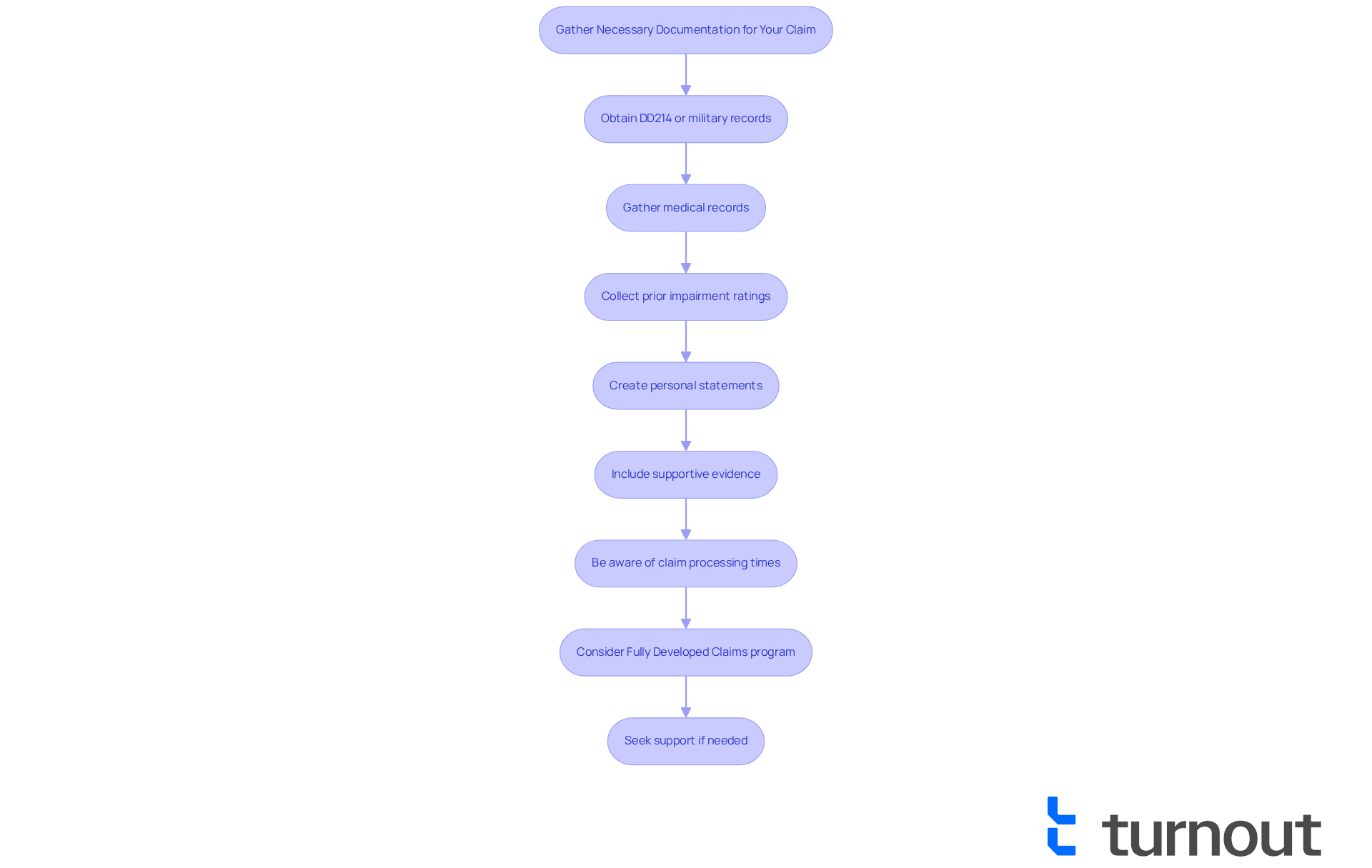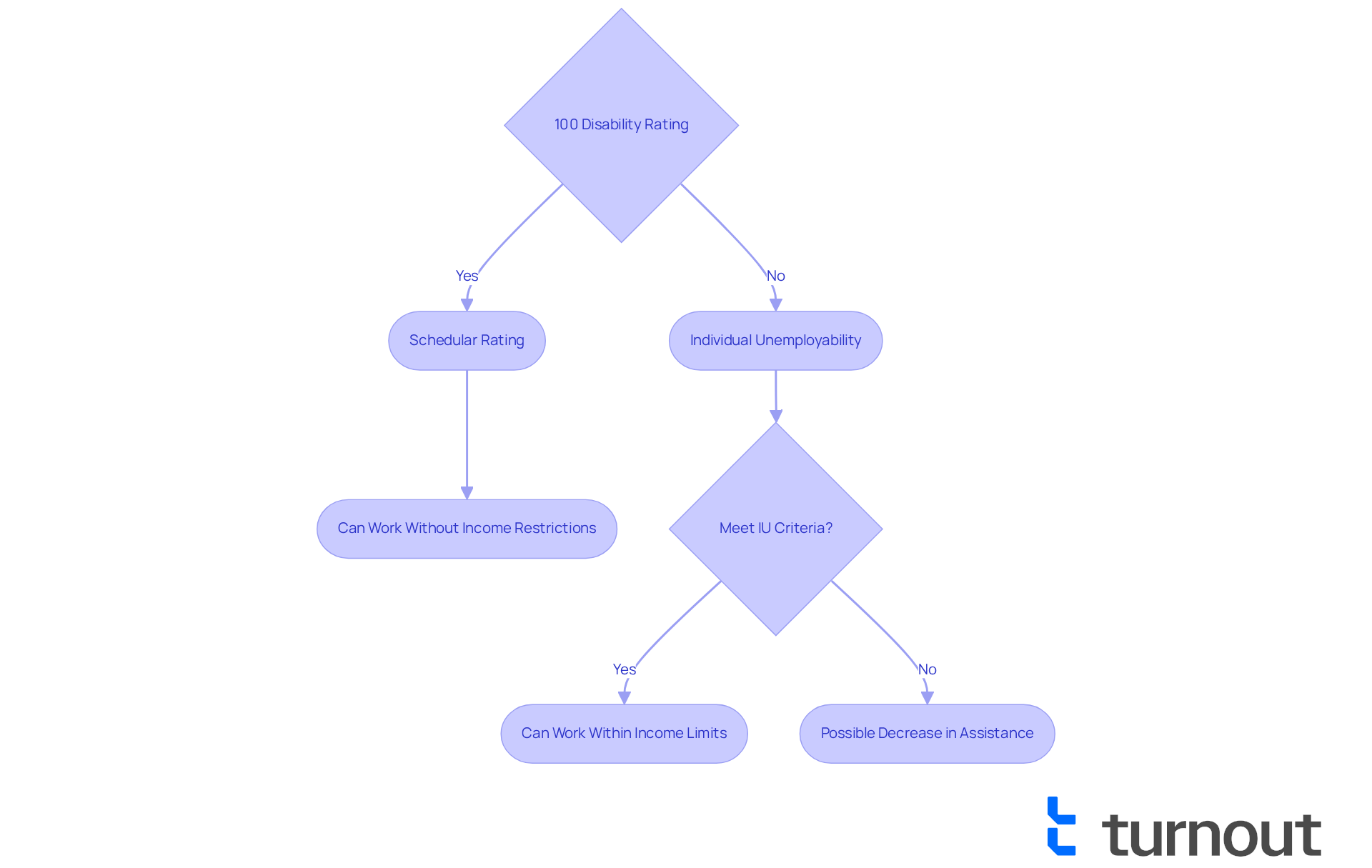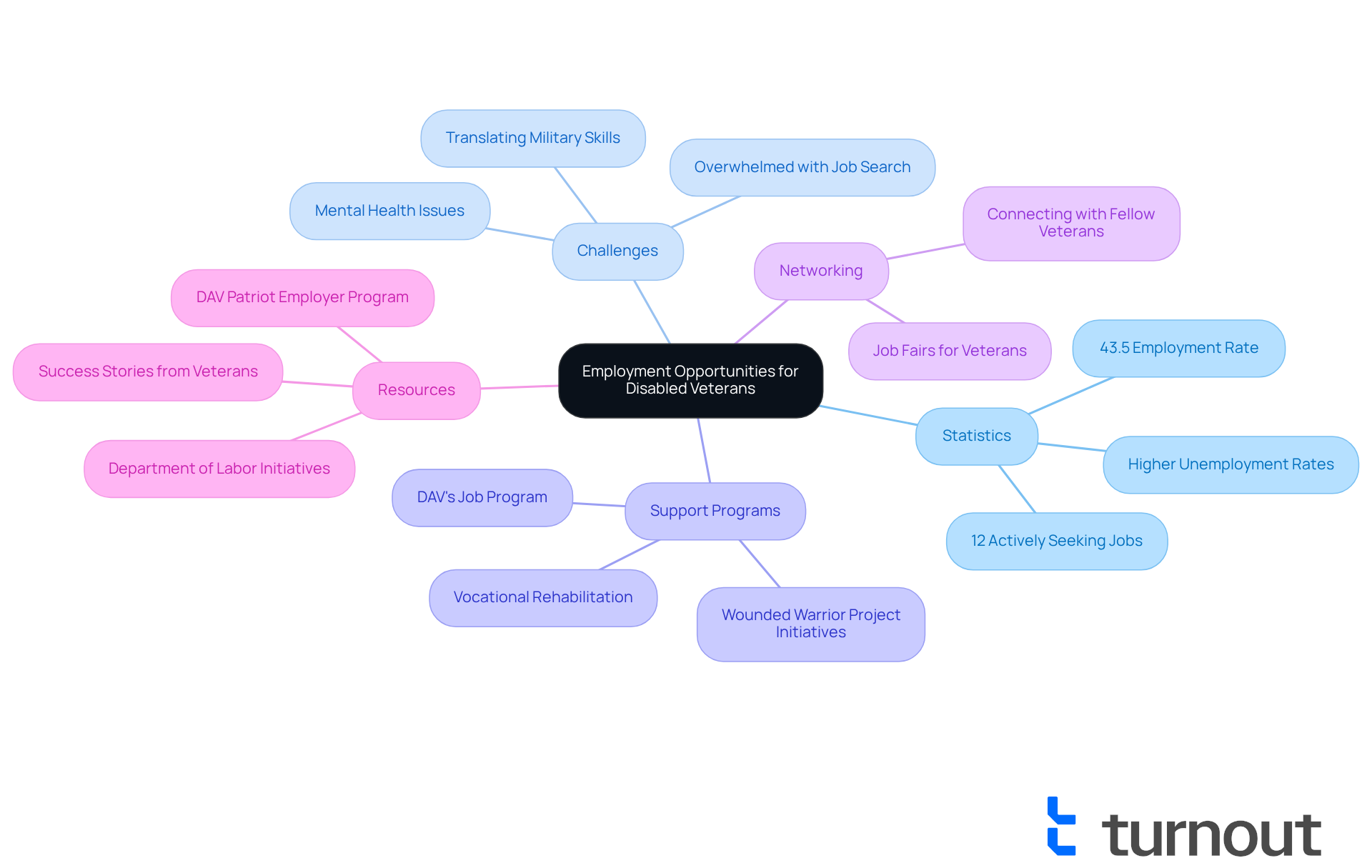Overview
If you're a 100% disabled veteran, you might wonder about your ability to work. It's important to know that while you can work, your situation may vary based on whether you qualify for Individual Unemployability (IU) or have a schedular rating.
We understand that navigating these options can be challenging. Veterans rated at 100% can work freely, but those receiving IU may face income limitations. This distinction is crucial, as it can significantly impact your benefits.
Understanding your specific eligibility criteria is essential. It’s common to feel overwhelmed, but you’re not alone in this journey. We’re here to help you make sense of it all.
Take the time to explore your options and know that support is available. Your well-being matters, and being informed can empower you to make the best decisions for your future.
Introduction
Navigating the complexities of disability benefits can feel overwhelming for veterans. If you’re a 100% disabled veteran, you might be asking yourself: Can I still work? It’s a common concern among former service members who wonder about their eligibility for employment while receiving benefits. You may also be thinking about how your work could affect your disability ratings.
This article aims to provide you with essential steps and insights. We’ll help you verify your eligibility for Individual Unemployability, gather the necessary documentation, and understand how employment opportunities can align with the unique challenges you face as a disabled veteran. As the landscape evolves, especially with upcoming VA regulations, it’s crucial to know: can a 100% disabled veteran truly balance work and benefits without jeopardizing their support?
We understand that this journey can be daunting, but you are not alone. Together, we’ll explore the options available to you.
Verify Eligibility for Individual Unemployability
To verify your eligibility for Individual Unemployability, let’s walk through these important steps together:
-
First, confirm that you have a service-connected condition rated at least 60%, or a combination of conditions that equals 70%. It’s essential that at least one of your impairments is rated 40% or higher.
-
Next, review your current impairment rating and any recent changes that might affect your eligibility. Staying informed about updates, especially with the new VA regulations coming in 2025, is crucial.
-
Consider whether your limitations hinder you from assessing if a 100% disabled veteran can work in significantly profitable employment. This is a key factor in qualifying for Individual Unemployability.
If you’re feeling uncertain about your eligibility status, remember that seeking advice from a specialist can be incredibly helpful. They can provide clarity and guide you through the complexities of your situation. As one expert wisely noted, "Verifying your disability rating is crucial to guarantee you obtain the support you deserve."
It’s important to keep in mind that former service members have one year to contest a rejected claim for Total Disability based on Individual Unemployability before the decision becomes final.
Many former military personnel may qualify for Individual Unemployability assistance, and it raises the question of whether a 100% disabled veteran can work, as some might even be eligible on an extraschedular basis if they don’t meet the typical percentage criteria. Understanding these specific requirements is essential for a successful claim. For instance, consider a veteran with a service-related heart condition who was initially assessed at 60%. They were later deemed individually unemployable due to deteriorating health, which resulted in their compensation being increased to the same level as a 100% disabled veteran.
Turnout is here to simplify your access to these benefits. We provide expert guidance to help you navigate the complexities of the system, including assistance with SSD claims and tax debt relief. Please note that Turnout does not provide legal representation. Remember, you are not alone in this journey.

Gather Necessary Documentation for Your Claim
-
Obtaining your DD214 or other military service records is a crucial first step in verifying your service history. You can easily request these records online using the National Archives’ eVetRecs tool. Just make sure you have an identity-verified ID.me account to get started.
-
Next, gather thorough medical records that detail your service-connected conditions. This includes any treatment records and evaluations that link your military service to your current health issues. We understand that this can feel overwhelming, but having this documentation is vital.
-
Don’t forget to collect any prior impairment ratings or determinations from the VA. This information can provide valuable context for your current claim and help illustrate how your challenges have developed over time.
-
Creating personal statements about how your impairments affect your ability to work can demonstrate how a 100% disabled veteran can work incredibly impactful. These narratives help convey the real-world effects of your conditions, making your case stronger.
-
Additionally, consider including supportive evidence like buddy statements or vocational assessments. These documents can further validate your experiences and the challenges you face.
-
It's important to be aware that the average time to complete disability-related claims is currently 88.2 days. You have up to a year from the date the VA receives your claim to submit any additional evidence. Timely submission of all required documentation is essential to avoid delays in processing your claim.
-
Have you thought about utilizing the Fully Developed Claims program? This option allows you to submit all necessary evidence at once, which can lead to faster decisions on your disability benefits.
-
Remember, many former service members experience emotional difficulties during the claims process, especially after initial rejections. Seeking support from accredited representatives or organizations can significantly improve your chances of success. You are not alone in this journey, and we're here to help.

Understand Impact of Employment on Disability Ratings
Understanding the difference between a 100% schedular rating and a 100% rating based on Individual Unemployability (IU) is crucial for veterans. We know that navigating these ratings can be overwhelming, but it’s important to recognize that the question of whether can a 100 disabled veteran work is answered positively, as they can do so without any income restrictions. This freedom allows them to explore job opportunities without worry. On the other hand, those rated as 100% due to IU may face limitations on their income and employment activities, which can be a source of concern.
To qualify for IU, the VA specifies that individuals must demonstrate that their service-related impairments prevent them from engaging in substantial gainful activity (SGA). Dominique Joseph, a claims processor at the Appeals Management Center, explains, "In order to qualify for IU, you must have one of the following:
- a 60-percent or more disability evaluation based on a single service-connected disability or,
- a 70-percent combined disability evaluation based on multiple service-connected disabilities, with at least one disability rated at 40 percent or more."
This means that while individuals receiving IU assistance can work, their income must not surpass the federal poverty threshold set by the Social Security Administration.
It’s essential to refer to the VA's guidelines on how work income might influence your assistance. We understand that maintaining precise documentation of any changes in employment status can feel daunting. However, it’s vital for former service members to notify the VA of these changes to ensure compliance and prevent possible decreases in assistance. For instance, not submitting the VA’s Employment Questionnaire Form 21-4140 when asked can lead to a decrease in TDIU assistance.
Many former service members successfully manage part-time employment while receiving assistance, as long as they stay within the income limits established by the VA. For example, an individual with a 70% impairment rating may find a flexible part-time position that accommodates their health needs, ensuring they do not exceed the income cap. Grasping these subtleties can empower former service members to make informed choices regarding their job opportunities while protecting their benefits, especially when considering the question of can a 100 disabled veteran work?. Remember, you are not alone in this journey, and we’re here to help.

Explore Employment Opportunities Suitable for Disabled Veterans
-
We understand that finding employment can be a challenging journey for former service members, particularly regarding how can a 100 disabled veteran work. Many organizations are dedicated to creating inclusive work environments that recognize the unique skills and experiences you bring. Did you know that the employment rate for working-age individuals with disabilities is just 43.5%? This statistic highlights a significant opportunity for companies to tap into this valuable talent pool, particularly in remote work settings that offer flexibility and reduce physical strain.
-
It's common to feel overwhelmed when searching for remote work options that accommodate your health needs, particularly when considering how can a 100 disabled veteran work. Approximately 12% of disabled service members are actively seeking jobs, and this raises the question of how a 100 disabled veteran can work, as remote roles can bridge the gap between your skills and available opportunities. This is especially important given the higher unemployment rates faced by disabled individuals compared to their nondisabled peers.
We encourage you to explore vocational rehabilitation programs designed to assist former service members in securing meaningful employment, especially for those who can a 100 disabled veteran work. These initiatives focus on skill development and connecting you with employers who value your military experience. The U.S. Department of Labor is committed to increasing job opportunities for 5 million disabled former service members, highlighting the issue of whether can a 100 disabled veteran work.
-
Connecting with fellow former service members can be incredibly beneficial. Sharing experiences and insights can provide valuable perspectives on the job market. Across the country, job fairs specifically for military personnel are held, offering a great chance to meet potential employers and network with others who understand your journey.
-
Don't forget to utilize resources like the DAV's job program for career counseling and job fairs, especially to understand how can a 100 disabled veteran work. The DAV Patriot Employer Program recognizes organizations that implement hiring practices favorable to former service members, making it easier for you to find fulfilling careers. As the Secretary of Labor stated, "One of the most significant ways we can honor their service is by enhancing job opportunities for all former service members, including those with disabilities." Additionally, hearing success stories from veterans who have transitioned to remote work can inspire and guide you as you navigate your own path.

Conclusion
Navigating the complexities of employment as a 100% disabled veteran can feel overwhelming. But it’s important to know that opportunities are out there. This article has highlighted the essential steps for verifying eligibility for Individual Unemployability, gathering necessary documentation, and understanding how employment affects disability ratings. By empowering veterans with this knowledge, we want to convey a hopeful message: it is indeed possible for a 100% disabled veteran to work while keeping their benefits.
Key insights include:
- Confirming eligibility criteria
- The importance of thorough documentation
- The nuances between different disability ratings
We also discussed the value of supportive resources and programs designed to help veterans find employment. Remember, there are pathways available to achieve meaningful work without jeopardizing your benefits.
Ultimately, the journey toward employment as a disabled veteran isn’t just about navigating claims and paperwork; it’s about reclaiming your agency and discovering a fulfilling role in the workforce. By leveraging available resources and connecting with others who share similar experiences, you can pave your way to success. The significance of these insights cannot be overstated. They empower former service members to make informed decisions about their careers while ensuring they receive the support they deserve.
So, as you consider your next steps, remember: you are not alone in this journey. We’re here to help you navigate the path ahead.
Frequently Asked Questions
What is the eligibility requirement for Individual Unemployability?
To be eligible for Individual Unemployability, you must have a service-connected condition rated at least 60%, or a combination of conditions that equals 70%. Additionally, at least one of your impairments must be rated 40% or higher.
How can I verify my current impairment rating?
You should review your current impairment rating and any recent changes that might affect your eligibility. Staying informed about updates, especially with the new VA regulations coming in 2025, is crucial.
What factors determine if I can qualify for Individual Unemployability?
You need to consider whether your limitations prevent you from working in significantly profitable employment. This is a key factor in qualifying for Individual Unemployability.
What should I do if I’m uncertain about my eligibility status?
If you're uncertain about your eligibility status, seeking advice from a specialist can be very helpful. They can provide clarity and guide you through the complexities of your situation.
How long do I have to contest a rejected claim for Total Disability based on Individual Unemployability?
Former service members have one year to contest a rejected claim for Total Disability based on Individual Unemployability before the decision becomes final.
Can a 100% disabled veteran work and still receive benefits?
Yes, a 100% disabled veteran can work, and some veterans may even qualify for Individual Unemployability on an extraschedular basis if they don’t meet the typical percentage criteria.
Can you provide an example of how a veteran might qualify for Individual Unemployability?
For instance, a veteran with a service-related heart condition initially assessed at 60% might be deemed individually unemployable due to deteriorating health, which could increase their compensation to the same level as a 100% disabled veteran.
What services does Turnout provide to assist with Individual Unemployability claims?
Turnout provides expert guidance to help navigate the complexities of the system, including assistance with SSD claims and tax debt relief. However, they do not provide legal representation.




